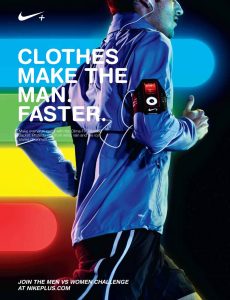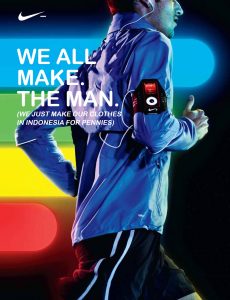Original Ad:

Men vs. Women Challenge
Analysis of Original Ad:
This advertisement that I’ve selected sits within the sphere of a larger ad campaign by Nike that aimed to illicit gendered competition between men and women runners in an online race. Participants were encouraged to download apps and purchase Nike products that would allow them to track and share their running statistics online which would then be compared against other participants in this virtual race.
Though both men and women were presented with gender-targeted advertisements, this ad is geared towards male participants. Appealing to the stereotypical dominant behaviour of a man, the ad implies that purchasing Nike’s clothing will offer males a competitive advantage against their female opponents. Furthermore, by instigating this ‘battle of the sexes’ competition, the advertiser is attempting to exploit a socially constructed threat to the male ego that one might be less of a man if a woman beats him in a test of physical endurance. According to Nike, this ego threat can be avoided and male dominance guaranteed if one purchases their products.
The ad also belittles females by likening the “cold, icy stares of women” as something equitable to the unpleasantness of running through rain and snow. This comparison further punctuates a misogynistic view of women as unpleasant and deserving of subjugation by men. To top it all off, the male model in the ad is featured as having his hand in a ‘thumbs up’ position, which subtly seems to reaffirm the perspective in the ad as being correct in its trajectory and message.
Encouraging conspicuous consumption by appealing to patriarchal notions of domination and control of women by men is the underlying message within this male-focussed advertisement.
Jammed Ad:

Jammed Version of Ad
Jamming Philosophy:
To redirect the message in the ad and subvert the original advertisement, I’ve opted to change the key statement in the ad to one that reads: “We all make the man.” The idea behind this edit is meant to bring awareness to the perspective that misogyny is propagated, in part, by the cultural, patriarchal teachings instilled to young boys and girls that translates to oppressive behaviour and actions by adult men and society at large. This shifts the responsibility to the social institutions that shape much of the thoughts and behaviours of individuals and groups that are oppressive towards women. The edit is intended to neutralize the message that there is something natural and wonderful about promoting gendered competition and domination. Furthermore, this statement hopes to illicit action towards changing our social consciousness in terms of what we teach our children about what it means to be a man or a woman, and perhaps shifting away from the standard narrative of men being the dominant sex with some natural right to oppress women.
As mentioned, the original ad almost spoon feeds the idea that the purchasing of their products makes a person better, thereby encouraging conspicuous consumption. I’ve attempted to tarnish the positive spin of such a perspective by showing that consumerism only benefits Nike financially in its exploitation of low-cost labourers in Indonesia. The addition of “(we just make our clothes in Indonesia for pennies)” replaces the misogynistic comparison of women to unpleasant weather in the original ad with a statement that illuminates the fact that Nike is a for-profit business that uses poor workers in impoverished nations. In addition to the aforementioned, the references to the “Men vs. Women Challenge” has been completely wiped from the advertisement.
Finally, the Nike swoosh logo which is tagged with a “+” in the original ad is replaced to with a minus symbol in a subversive response to the “thumbs up” pose that the model has in the ad. The minus symbol is associated with negative effect, which further mocks the misogynistic message that Nike presents in the original ad as being supportive of institutional sexism and the patriarchy.